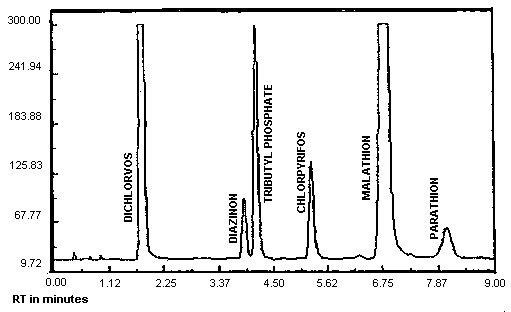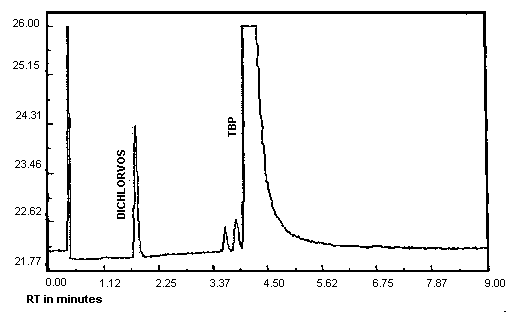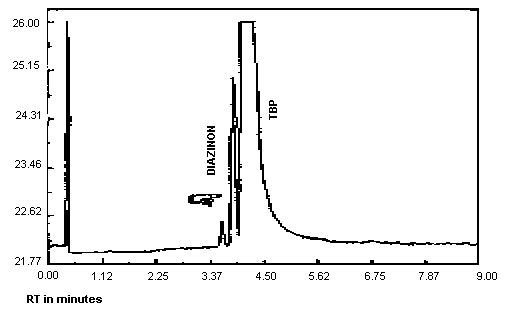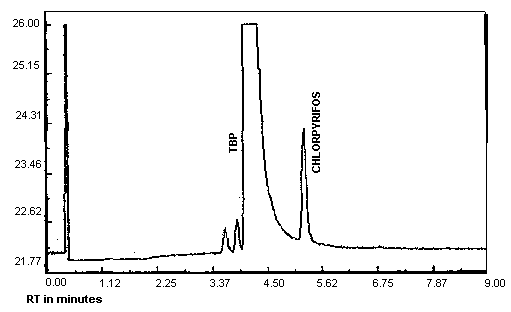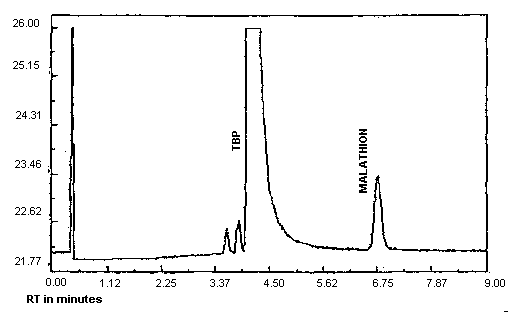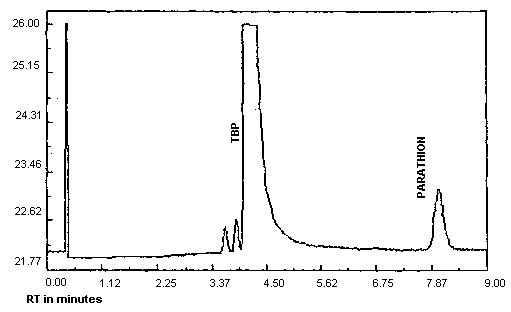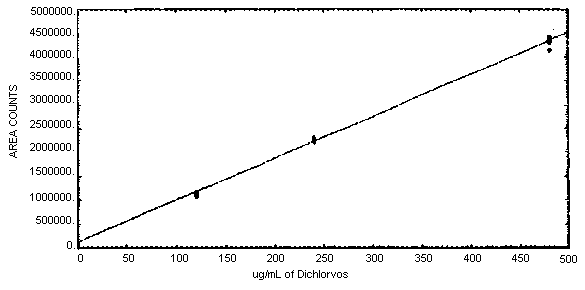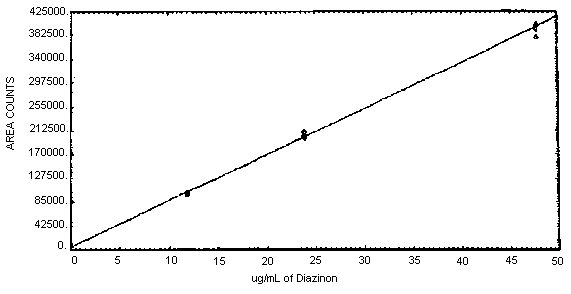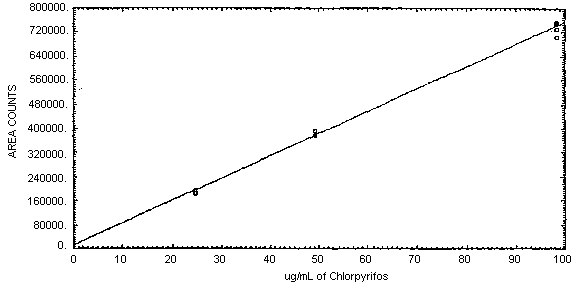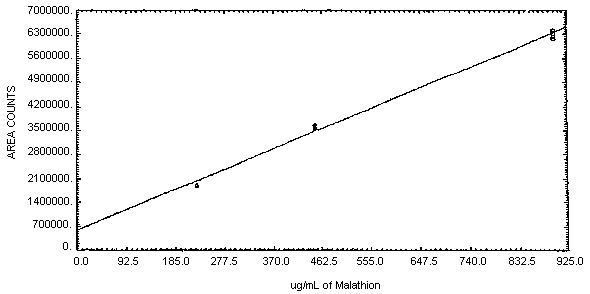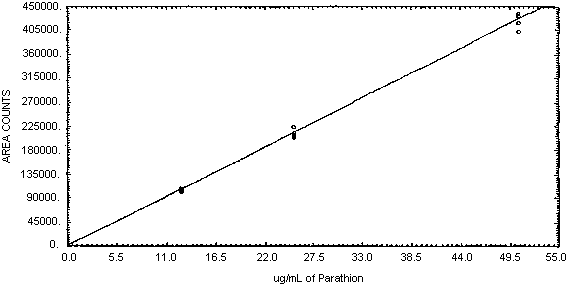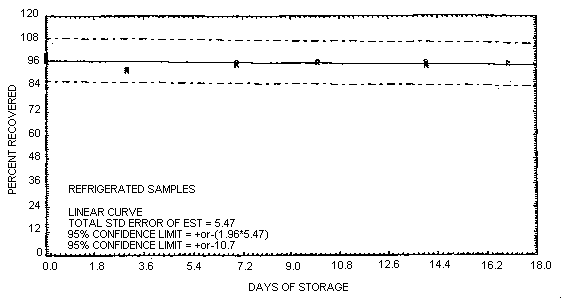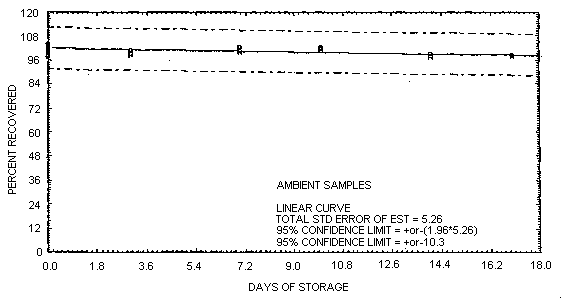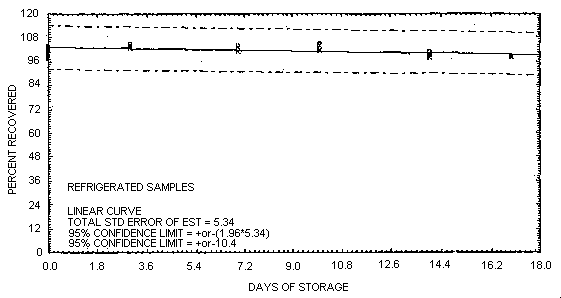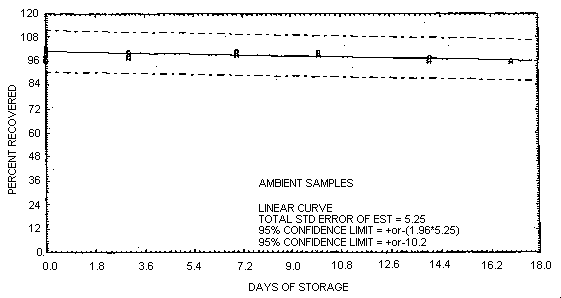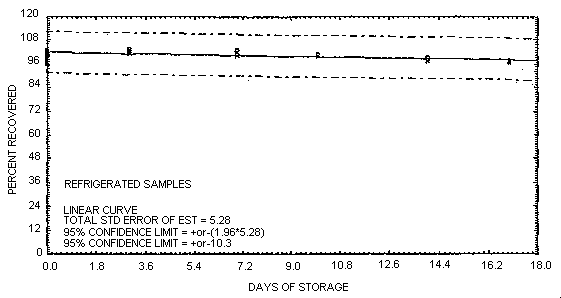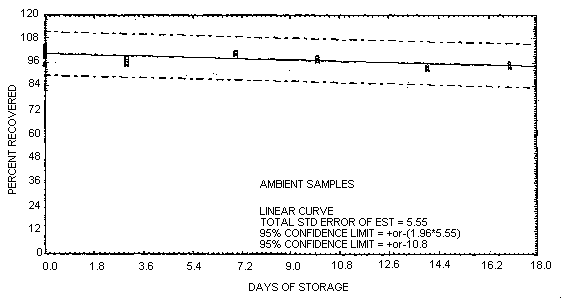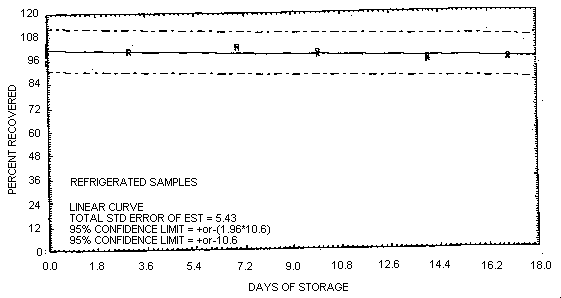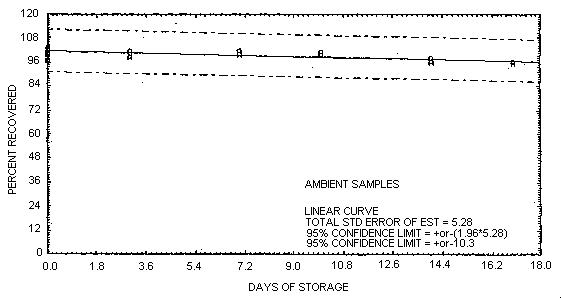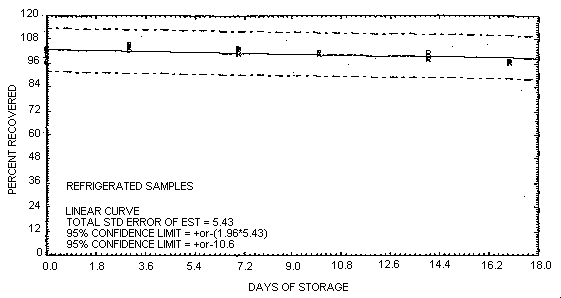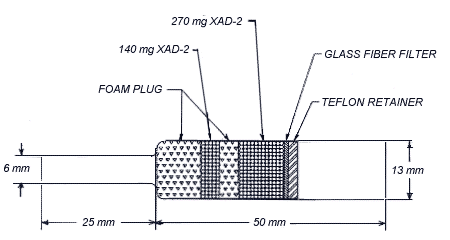DDVP (DICHLORVOS)
DIAZINON
MALATHION
PARATHION
| Method no.: | 62 |
| Matrix: | Air |
| Procedure: | Samples are collected by drawing known volumes of air
through specially constructed glass sampling tubes, each containing
a glass fiber filter and two sections of |
| Recommended air volume and sampling rate: |
480 L at 1.0 L/min except for Malathion 60 L at 1.0 L/min for Malathion |
| Status of method: | Evaluated method. This method has been subjected to the established evaluation procedures of the Organic Methods Evaluation Branch. |
| Date: October 1986 | Chemist: Donald Burright |
OSHA Analytical Laboratory
Salt Lake City, Utah
| Target concentrations: | 1.0 mg/m3
(0.111 ppm) for Dichlorvos (PEL) 0.1 mg/m3 (0.008 ppm) for Diazinon (TLV) 0.2 mg/m3 (0.014 ppm) for Chlorpyrifos (TLV) 15.0 mg/m3 (1.11 ppm) for Malathion (PEL) 0.1 mg/m3 (0.008 ppm) for Parathion (PEL) |
| Reliable quantitation limits: (based on the RAV) |
0.0019 mg/m3 (0.21 ppb) for
Dichlorvos 0.0030 mg/m3 (0.24 ppb) for Diazinon 0.0033 mg/m3 (0.23 ppb) for Chlorpyrifos 0.0303 mg/m3 (2.2 ppb) for Malathion 0.0031 mg/m3 (0.26 ppb) for Parathion |
| Standard errors of estimate at the target concentration: (Section 4.6.) |
5.3% for Dichlorvos 5.3% for Diazinon 5.3% for Chlorpyrifos 5.6% for Malathion 5.3% for Parathion |
1. General Discussion
- 1.1. Background
- 1.1.1. History
This evaluation was undertaken to develop and evaluate a common
sampling procedure for both vapors and aerosols of five
organophosphorus pesticides which are frequently analyzed by the
OSHA Analytical Laboratory. There are several methods which describe
procedures for the sampling of organophosphorus pesticides. These
require a variety of sampling media: glass fiber filters, ethylene
glycol impingers,
The sampling procedure specified in this method uses a specially
prepared glass tube containing
1.1.2. Toxic effects (This section is for information only and should not be taken as a basis for OSHA policy.)
The organophosphorus pesticides have a great potential for acute intoxication which varies considerably from compound to compound. Parathion is very toxic with an oral LD50 in rats of about 2 mg/kg. Malathion is one of the least toxic organophosphorus pesticides with an oral LD50 in rats of 1400 mg/kg. These substances exert their toxic effects through their ability to inhibit cholinesterase. (Ref. 5.4.)
Increased bronchial secretion, salivation, sweating, bradycardia, anxiety, headache, neurosis, slurred speech, disorientation, and convulsions are signs and symptoms that characterize poisoning by organophosphorus pesticides in workers. Respiratory failure is the most usual cause of death from a single, high dose. (Ref. 5.4.)
Malathion and dichlorvos have shown no clear evidence of carcinogenicity in test animals. Parathion, diazinon and dichlorvos are reported to be slightly teratogenic in test animals. (Ref. 5.4.)
All of the organophosphorus pesticides in this evaluation are absorbed through the skin and this is noted in the lists of OSHA PELs and ACGIH TLVs.
1.1.3. Workplace exposure
In 1975, 666 million pounds of pesticides (organophosphorus, organochlorine and carbamate pesticides) were produced in the United States. An estimated 8700 workers were employed in the manufacture and formulation of pesticides in 1972. However, in these industries there are over 350,000 additional production employees who have the potential for exposure because they work at a plant that produces pesticides. (Ref. 5.4.)
1.1.4. Physical properties and other descriptive information (Ref. 5.5. unless otherwise indicated)
Dichlorvos
| CAS no.: | 62-73-7 |
| MW: | 220.98 |
| density: | 1.415 at 25°C |
| boiling point: | 117°C at 10 mm Hg |
| vapor pressure: | 0.012 mm Hg at 20°C |
| color: | colorless to amber |
| molecular formula: | C4H7Cl2O4P |
| synonyms: | |
| structure: |  |
Diazinon
| CAS no.: | 333-41-5 |
| MW: | 304.36 |
| density: | 1.117 at 20°C |
| boiling point: | 83-84°C at 0.002 mm Hg |
| vapor pressure: | 0.00014 mm Hg |
| color: | colorless liquid |
| molecular formula: | C12H21N2O3PS |
| synonyms: | |
| structure: | 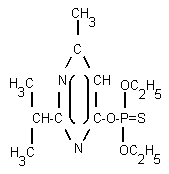 |
Chlorpyrifos
| CAS no.: | 2921-88-2 |
| MW: | 350.57 |
| melting point: | 41-42°C |
| vapor pressure: | 0.0000187 mm Hg at 25°C |
| color: | white crystals |
| molecular formula: | C9H11Cl3NO3PS |
| synonyms: | |
| structure: | 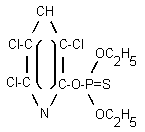 |
Malathion
| CAS no.: | 121-75-5 |
| MW: | 330.36 |
| density: | 1.23 at 25°C |
| boiling point: | 156°C at 0.7 mm Hg |
| melting point: | 2.9°C |
| vapor pressure: | 0.00004 mm Hg at 20°C |
| color: | clear to amber liquid |
| molecular formula: | C10H19O6PS2 |
| synonyms: | [(dimethoxyphosphinothioyl) thio] butanedioic acid diethyl ester |
| structure: | 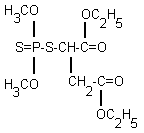 |
Parathion
| CAS no.: | 56-38-2 |
| MW: | 291.27 |
| density: | 1.267 at 25°C |
| boiling point: | 375°C at 760 mm Hg |
| melting point: | 6°C |
| vapor pressure: | 0.0000378 mm Hg at 20°C |
| color: | pale yellow liquid |
| molecular formula: | C10H14NO5PS |
| synonyms: | |
| structure: |  |
1.2. Limit defining parameters (The analyte air concentrations listed throughout this method are based on the appropriate air volume of 60 L for malathion or 480 L for the other pesticides and a solvent desorption volume of 2 mL. Air concentrations listed in ppm are referenced to 25°C and 760 mm Hg.)
- 1.2.1. Detection limits of the analytical procedure
The detection limits of the analytical procedure are listed below. These are the amounts of analytes which will give peaks whose areas are about 5 times that of a nearby contaminant. (Section 4.1.)
Analytical Detection Limits
|
| |
| compound | ng/injection |
|
| |
| Dichlorvos | 0.55 |
| Diazinon | 0.91 |
| Chlorpyrifos | 0.99 |
| Malathion | 1.1 |
| Parathion | 0.94 |
|
| |
1.2.2. Detection limits of the overall procedure
The detection limits of the overall procedure are listed below. These are the amounts of each analyte spiked on the sampling device which allow recoveries of amounts equivalent to the detection limits of the analytical procedure. (Section 4.2.)
Detection Limits of the Overall
Procedure
and Reliable Quantitation Limits
|
| |||||
| Dichlorvos | Diazinon | Chlorpyrifos | Malathion | Parathion | |
|
| |||||
| µg/sample | 0.92 | 1.5 | 1.6 | 1.8 | 1.5 |
| µg/m3 | 1.9 | 3.0 | 3.3 | 30 | 3.1 |
| ppb | 0.21 | 0.24 | 0.23 | 2.2 | 0.26 |
|
| |||||
1.2.3. Reliable quantitation limits
The reliable quantitation limits are listed in Table 1.2.2. and are equal to the detection limits of the overall procedure. These are the smallest amounts of each analyte which can be quantitated within the requirements of a recovery of at least 75% and a precision (±1.96 SD) of ±25% or better. (Section 4.2.)
1.2.4. Instrument response to the analytes
The instrument response over the concentration range of 0.5 to 2 times the target concentrations is linear. (Section 4.4.)
1.2.5. Recoveries
The recoveries of each analyte from samples used in a 17-day storage test remained above the percentages listed below when the samples were stored at about 22°C. (Section 4.6.) The recovery of the analytes from the collection medium during storage must be 75% or greater.
Recoveries from Ambient Storage
|
| |
| compound | % |
|
| |
| Dichlorvos | 91.2 |
| Diazinon | 98.5 |
| Chlorpyrifos | 96.6 |
| Malathion | 94.6 |
| Parathion | 96.7 |
|
| |
1.2.6. Precisions (analytical procedure)
The pooled coefficients of variation obtained from replicate determinations of analytical standards at 0.5, 1 and 2 times the target concentration are shown below. (Section 4.3.)
Precision of the Analytical Procedure
|
| |
| compound | pooled CV |
|
| |
| Dichlorvos | 0.024 |
| Diazinon | 0.021 |
| Chlorpyrifos | 0.025 |
| Malathion | 0.012 |
| Parathion | 0.029 |
|
| |
1.2.7. Precisions (overall procedure)
The precisions at the 95% confidence level for the 17-day ambient temperature storage tests are listed below. (Section 4.6.) These each include an additional ±5% for sampling error. The overall procedure must provide results at the target concentration that are ±25% or better at the 95% confidence level.
Precision of the Overall Procedure
|
| |
| compound | % |
|
| |
| Dichlorvos | 10.3 |
| Diazinon | 10.3 |
| Chlorpyrifos | 10.2 |
| Malathion | 10.8 |
| Parathion | 10.3 |
|
| |
1.2.8. Reproducibilities
Six samples, spiked by liquid injection with the analytes, and a draft copy of this procedure were given to a chemist unassociated with this evaluation. The samples were analyzed after 35 days of storage at about 0°C. No individual sample deviated from its theoretical value by more than the precision reported in Section 1.2.7. (Section 4.7.)
1.3. Advantages
- 1.3.1. The sampling procedure provides a common sampling device
to collect a number of organophosphorus pesticides.
1.3.2. Full 8-h samples can be taken of dichlorvos, diazinon, chlorpyrifos and parathion at the target concentration.
1.4. Disadvantage
Currently, the sampling tube is not commercially available.
2. Sampling Procedure
- 2.1. Apparatus
- 2.1.1. Samples are collected by use of a personal sampling pump
that can be calibrated to within ±5% of the recommended flow rate
with the sampling device in line.
2.1.2. Samples are collected on specially made 11-mm i.d. × 13-mm
o.d. × 5.0 cm long glass tubes which are packed with a 140-mg backup
section and a 270-mg sampling section of cleaned
The backup section is retained by two foam plugs and the sampling section is between one foam plug and the glass fiber filter. The glass fiber filter is held next to the sampling section by a polytetrafluoroethylen (PTFE) retainer. (Sections 4.11.-4.12. and Figure 4.12.)
2.2. Reagents
No sampling reagents are required.
2.3. Sampling technique
- 2.3.1. Attach the sampling tube to the sampling pump with
flexible, plastic tubing such that the large, front section of the
sampling tube is exposed directly to the atmosphere. Do not place
any tubing in front of the sampler. The sampler should be attached
vertically (large end down) in the worker's breathing zone in such a
manner that it does not impede work performance.
2.3.2. After sampling for the appropriate time, remove the sampling device and seal the tube with plastic end caps.
2.3.3. Wrap each sample end-to-end with an OSHA seal (Form 21).
2.3.4. With each set of samples, submit at least one blank. The blank should be handled the same as the other samples except that no air is drawn through it.
2.3.5. Bulk samples should be sent for analysis in a separate container and not with the air samples.
2.4. Sampler capacity
When controlled test atmospheres, containing aerosols of 0.9 mg/m3 of diazinon (9 times the TLV) or 38.8 mg/m3 of malathion (2.5 times the OSHA PEL), were sampled using the recommended sampling device, less than 5% breakthrough was observed after sampling for 1.5 times the recommended air volume. Five-percent breakthrough was defined as the point at which 5% of the total collected on the entire tube was found on the backup section. (Section 4.9.) Since some of the analytes were not readily available in sufficient quantity, diazinon and malathion were the only organophosphorus pesticides used to produce a concentrated test aerosol. They were selected for the study because they represented the two extremes when comparing target concentrations. Diazinon was used to test the sampler's ability to collect a sample for 8 h. Malathion was used to test the maximum amount of analyte that the sampler would hold. The other three organophosphorus pesticides of this evaluation should collect just as well based on the results of the retention test.
To test the sampler's ability to retain organophosphorus pesticides, a target concentration amount of each analyte was liquid spiked onto 6 sampling tubes. Humid air (about 80% relative humidity) was pulled through the tubes for about 8 h at 1 L/min. When the samples were analyzed, it was found that all the analytes were present at levels equal to 99-102% of the spiked amounts. (Section 4.8.)
The new sampling tube was compared, side-by-side, with an ethylene glycol bubbler in several test atmospheres containing an aerosol of diazinon. The amount of diazinon collected by the two samplers was about the same. (Section 4.10.)
2.5. Extraction and desorption efficiencies
- 2.5.1. The extraction efficiencies from the glass fiber filters
are listed below. (Section 4.5.)
Extraction Efficiencies from GFF
|
| |
| compound | % |
|
| |
| Dichlorvos | 100.0 |
| Diazinon | 96.5 |
| Chlorpyrifos | 97.9 |
| Malathion | 95.9 |
| Parathion | 97.8 |
|
| |
2.5.2. The average desorption efficiencies from the lot of
cleaned
Average Desorption Efficiencies from
|
| |
| compound | % |
|
| |
| Dichlorvos | 97.4 |
| Diazinon | 98.0 |
| Chlorpyrifos | 98.8 |
| Malathion | 100.4 |
| Parathion | 97.5 |
|
| |
2.5.3. Extracted/desorbed samples remain stable for at least 24 h. (Section 4.5.)
2.6. Recommended air volume and sampling rate
- 2.6.1. The recommended air volume is 480 L for all the analytes
except Malathion which is 60 L.
2.6.2. The recommended air sampling rate is 1.0 L/min.
2.6.3. When short-term air samples are required, the recommended sampling rate is 1 L/min. A 15-min sample at the reliable quantitation limit is equivalent to the following values.
Short-term Limit
|
| |
| compound | mg/m3 |
|
| |
| Dichlorvos | 0.061 |
| Diazinon | 0.097 |
| Chlorpyrifos | 0.100 |
| Malathion | 0.120 |
| Parathion | 0.098 |
|
| |
2.7. Interferences (sampling)
Suspected interferences should be reported to the laboratory with submitted samples.
2.8. Safety precautions (sampling)
- 2.8.1. The sampling equipment should be attached to the worker
in such a manner that it will not interfere with work performance or
safety.
2.8.2. All safety practices that apply to the work area being sampled should be followed.
3. Analytical Procedure
- 3.1. Apparatus
- 3.1.1. A gas chromatograph (GC) equipped with a flame
photometric detector (FPD). A Hewlett-Packard 5730A GC fitted with
an FPD operating in the phosphorus mode was used in this evaluation.
Injections were performed using a Hewlett-Packard 7671A automatic
sampler.
3.1.2. A GC column capable of resolving the pesticides from any interference. A 30-m × 0.53-mm i.d. DB-210 Megabore GC column, 1.0-µm depth of film, was used in this evaluation and is available from J&W Scientific, Inc., Rancho Cordova, CA.
3.1.3. Vials, 2 and 4-mL glass with PTFE-lined caps.
3.1.4. Volumetric flasks, pipets and syringes for preparing standards, making dilutions and performing injections.
3.1.5. Analytical balance.
3.2. Reagents
- 3.2.1. Hydrogen, air, oxygen and nitrogen, GC grade.
3.2.2. Dichlorvos. The origin of the dichlorvos used in this evaluation is unknown but dichlorvos can be obtained from Chem Services.
3.2.3. Diazinon, chlorpyrifos, malathion and parathion. Analytical standards from Chem Services were used for this evaluation.
3.2.4. Toluene, pesticide grade.
3.2.5. Tributyl phosphate, reagent grade.
3.2.6. Extracting/desorbing solution. If an internal standard method is used, the extracting/desorbing solution is prepared by adding 8 µL of tributyl phosphate to 100 mL of toluene. Otherwise, only toluene is used.
3.3. Standard preparation
Stock standard solutions are prepared by adding the analytes to toluene. Working range standard solutions are prepared by injecting appropriate microliter volumes of stock solutions into sealed 2-mL glass vials containing desorbing solution.
3.4. Sample preparation
- 3.4.1. Transfer the glass fiber filter and the 270-mg section of
the sampling tube to a
3.4.2. Add 2.0 mL of desorbing solution to each vial.
3.4.3. Seal the vials with PTFE-lined caps and allow them to desorb for 1 h. Shake the vials by hand with vigorous force several times during the desorption time.
3.5. Analysis
- 3.5.1.
| GC conditions | |
| initial column temp: | 150°C |
| initial hold time: | 2 min |
| temp program rate: | 16°C/min |
| final column temp: | 200°C |
| final hold time: | 8 min |
| injector temp: | 200°C |
| nitrogen flow rate: | 5 mL/min |
| injection volume: | 1.3 µL |
| GC column: | 30 m × 0.53-mm i.d. DB-210 Megabore, 1.0-µm film |
| FPD conditions | |
| hydrogen flow rate: | 200 mL/min |
| oxygen flow rate: | 60 mL/min |
| air flow rate: | 30 mL/min |
| detector temp: | 300°C |
| chromatogram: | Figure 3.5.1. |
3.5.2. Use a suitable method, such as electronic integration, to measure detector response.
3.5.3. Use an internal standard procedure to prepare a calibration curve using several solutions over a range of concentrations. The calibration curve is prepared daily. The samples are bracketed with analytical standards.
3.6. Interferences (analytical)
- 3.6.1. Any compound having a similar retention time as the
analyte is a potential interference. Generally, chromatographic
conditions can be altered to separate an interference from the
analyte.
3.6.2. Retention time on a single column is not proof of chemical identity. Analysis by an alternate GC column, detection by an FPD detector in the sulfur mode for the sulfur containing pesticides, and mass spectrometry are additional means of identification.
3.7. Calculations
- 3.7.1. Results are obtained by use of calibration curves.
Calibration curves are prepared by plotting detector response
against concentration for each standard. The best line through the
data points is determined by curve fitting.
3.7.2. The concentration, in µg/mL, for a particular sample is determined by comparing its detector response to the calibration curve. If a pesticide is found on the backup section, it is added to the amount found on the front section. Blank corrections should be performed before adding the results together.
3.7.3. The air concentration of each pesticide can be expressed using the following equation:
mg/m3 = (A)(B)/(C)(D)
| where | A | = | µg/mL from Section 3.7.2. |
| B | = | extraction/desorption volume | |
| C | = | liters of air sampled | |
| D | = | correction factor for desorption and extraction efficiencies (decimal) |
The correction factor should be determined for the particular batch of resin and filter used for the sample. To obtain this value, the spiked samplers are analyzed as stated in Section 3.4.
3.8. Safety precautions (analytical)
- 3.8.1. Avoid exposure to all standards.
3.8.2. Avoid exposure to all solvents.
3.8.3. Wear safety glasses at all times.
4. Backup Data
- 4.1. Detection limits of the analytical
procedure
The detection limits of the analytical procedure are listed below. These amounts produced peaks whose areas were about 5 times the area of a nearby contaminant. The injection volume recommended in the analytical procedure (1.3 µL) was used in the determination of the detection limits for the analytical procedure. (Figures. 4.1.1.-4.1.5.)
The Detection Limits of the Analytical Procedure
|
| |||||
| Dichlorvos | Diazinon | Chlorpyrifos | Malathion | Parathion | |
|
| |||||
| ng/injection | 0.55 | 0.91 | 0.99 | 1.11 | 0.94 |
|
| |||||
4.2. Detection limits of the overall procedure and reliable quantitation limits
The injection size recommended in the analytical procedure (1.3 µL) was used in the determination of the detection limits of the overall procedure and in the determination of the reliable quantitation limits. Six samples were each liquid spiked with a solution containing an amount of each pesticide equal to its respective analytical detection limit. Since the recoveries of the pesticides from the samples were high and approximately equivalent to the detection limit of the analytical procedure, the detection limits of the overall procedure and reliable quantitation limits were the same.
Detection Limits of the Overall
Procedure and Reliable Quantitation Limits
|
| |||||
| Dichlorvos | Diazinon | Chlorpyrifos | Malathion | Parathion | |
| µg/sample | 0.92 | 1.5 | 1.6 | 1.8 | 1.5 |
| µg/m3 | 1.9 | 3.0 | 3.3 | 30.0 | 3.1 |
| ppb | 0.21 | 0.24 | 0.23 | 2.2 | 0.26 |
|
| |||||
| % recovered | 96.1 | 101.4 | 100.7 | 98.1 | 99.5 |
| 100.7 | 101.6 | 102.4 | 101.9 | 101.0 | |
| 95.6 | 102.6 | 101.5 | 102.9 | 100.1 | |
| 94.8 | 102.3 | 101.1 | 98.8 | 100.4 | |
| 94.5 | 103.0 | 101.0 | 98.5 | 99.9 | |
| 96.1 | 103.4 | 101.6 | 101.2 | 100.5 | |
| 96.3 | 102.4 | 101.4 | 100.2 | 100.2 | |
| SD | 2.2 | 0.8 | 0.6 | 2.0 | 0.5 |
| 1.96 SD | 4.4 | 1.6 | 1.2 | 4.0 | 1.0 |
|
| |||||
4.3. Precision (analytical method only)
The precision of the analytical method was evaluated by performing multiple injections of analytical standards.
Precision Data at 0.5× Target
Concentration
|
|
|||||
| Dichlorvos | Diazinon | Chlorpyrifos | Malathion | Parathion | |
| µg/mL | 120.5 | 11.95 | 24.63 | 224.8 | 12.65 |
|
| |||||
| area | 1185990 | 103755 | 198786 | 1905040 | 110989 |
| counts | 1125110 | 100516 | 188632 | 1908640 | 103930 |
| 1103090 | 98473 | 184429 | 1912120 | 105559 | |
| 1167270 | 102957 | 195703 | 1941630 | 107360 | |
| 1182980 | 103644 | 196519 | 1929490 | 107359 | |
| 1195290 | 103738 | 197442 | 1951340 | 109450 | |
| 1159955 | 102181 | 193585 | 1924710 | 107441 | |
| SD | 37304 | 2198 | 5716 | 19088 | 2550 |
| CV | 0.0322 | 0.0215 | 0.0295 | 0.0099 | 0.0237 |
|
| |||||
Precision Data at 1× Target Concentration
|
| |||||
| Dichlorvos | Diazinon | Chlorpyrifos | Malathion | Parathion | |
| µg/mL | 241 | 23.9 | 49.25 | 449.5 | 25.5 |
|
| |||||
| area | 2323170 | 211292 | 395118 | 3698720 | 226283 |
| counts | 2271550 | 205902 | 382438 | 3626800 | 209312 |
| 2266650 | 204886 | 380773 | 3568190 | 210488 | |
| 2253280 | 202571 | 378326 | 3595070 | 209809 | |
| 2248770 | 201906 | 377308 | 3652240 | 213875 | |
| 2238240 | 200205 | 377462 | 3670850 | 206860 | |
| 2266943 | 204460 | 381904 | 3635311 | 212771 | |
| SD | 30078 | 3928 | 6780 | 48512 | 6995 |
| CV | 0.0133 | 0.0192 | 0.0178 | 0.0133 | 0.0329 |
|
| |||||
Precision Data at 2× Target
Concentration
|
| |||||
| Dichlorvos | Diazinon | Chlorpyrifos | Malathion | Parathion | |
| µg/mL | 482 | 47.8 | 98.5 | 899 | 50.6 |
|
| |||||
| area | 4336740 | 400470 | 750063 | 6208470 | 431463 |
| counts | 4170580 | 379532 | 706018 | 6430650 | 403799 |
| 4323280 | 393259 | 733176 | 6262580 | 419880 | |
| 4369850 | 400784 | 747974 | 6278710 | 433163 | |
| 4425880 | 402397 | 755150 | 6279130 | 431327 | |
| 4408310 | 403883 | 755318 | 6355910 | 436763 | |
| 4339107 | 396721 | 741283 | 6302575 | 426066 | |
| SD | 91565 | 9182 | 19081 | 78512 | 12294 |
| CV | 0.0211 | 0.0231 | 0.0257 | 0.0125 | 0.0289 |
|
| |||||
Pooled Coefficient of Variation
|
| |||||
| Dichlorvos | Diazinon | Chlorpyrifos | Malathion | Parathion | |
|
| |||||
| 0.024 | 0.021 | 0.025 | 0.012 | 0.029 | |
|
| |||||
4.4. Instrument response to the analytes
The data in Tables 4.3.1.-4.3.3. are presented graphically in Figures 4.4.1.-4.4.5. These figures show calibration curves over the concentration range of 0.5 to 2 times the target concentrations. The instrument response is linear over this range.
Sensitivities
|
| |
| compound | area counts per µg/mL |
|
| |
| Dichlorvos | 8770 |
| Diazinon | 8190 |
| Chlorpyrifos | 7400 |
| Malathion | 6410 |
| Parathion | 8400 |
|
| |
4.5. Extraction and desorption efficiencies
- 4.5.1. Extraction from glass fiber filter
The data below represent the results of the analysis of glass fiber filters that were liquid spiked with the pesticides at the target concentrations. These samples were allowed to sit overnight and then extracted with the extracting solution and analyzed.
Extraction Efficiency of Pesticides at 1×
Target Concentration
|
| |||||
| Dichlorvos | Diazinon | Chlorpyrifos | Malathion | Parathion | |
| µg/sample | 482 | 47.8 | 98.5 | 899 | 50.6 |
|
| |||||
| extraction | 101.3 | 95.7 | 97.2 | 95.3 | 96.9 |
| efficiency, | 99.8 | 94.9 | 96.5 | 94.4 | 96.4 |
| % | 99.7 | 96.0 | 97.6 | 94.9 | 97.3 |
| 99.9 | 96.1 | 97.2 | 95.4 | 97.6 | |
| 99.1 | 97.0 | 98.1 | 96.6 | 98.6 | |
| 100.3 | 99.0 | 100.6 | 98.8 | 100.1 | |
| 100.0 | 96.5 | 97.9 | 95.9 | 97.8 | |
|
| |||||
4.5.2. Desorption from
The data below are the results of the analysis of
Desorption Efficiency of Pesticides at 0.5× Target Concentration
|
| |||||
| Dichlorvos | Diazinon | Chlorpyrifos | Malathion | Parathion | |
| µg/sample | 241 | 23.9 | 49.25 | 449.5 | 25.3 |
|
| |||||
| desorption | 98.3 | 94.2 | 95.8 | 96.1 | 92.8 |
| efficiency, | 98.0 | 94.3 | 95.8 | 98.8 | 92.8 |
| % | 98.5 | 94.7 | 96.5 | 96.7 | 93.4 |
| 98.6 | 94.3 | 96.1 | 106.2 | 93.1 | |
| 98.4 | 94.9 | 96.6 | 98.0 | 93.3 | |
| 98.4 | 95.7 | 97.4 | 98.4 | 93.9 | |
| 98.3 | 94.7 | 96.4 | 99.0 | 93.2 | |
|
| |||||
Desorption Efficiency of Pesticides at 1× Target Concentration
|
| |||||
| Dichlorvos | Diazinon | Chlorpyrifos | Malathion | Parathion | |
| µg/sample | 482 | 47.8 | 98.5 | 899 | 50.6 |
|
| |||||
| desorption | 97.4 | 96.8 | 97.7 | 98.7 | 95.9 |
| efficiency, | 97.4 | 97.4 | 98.9 | 99.0 | 96.2 |
| % | 96.8 | 97.2 | 98.9 | 99.5 | 96.2 |
| 96.5 | 97.6 | 99.3 | 99.6 | 96.5 | |
| 96.7 | 98.4 | 100.2 | 101.0 | 97.3 | |
| 96.2 | 98.8 | 100.6 | 101.4 | 98.1 | |
| 96.8 | 97.7 | 99.3 | 99.9 | 96.7 | |
|
| |||||
Desorption Efficiency of Pesticides at 2× Target Concentration
|
| |||||
| Dichlorvos | Diazinon | Chlorpyrifos | Malathion | Parathion | |
| µg/sample | 964 | 95.6 | 197 | 1798 | 101.2 |
|
| |||||
| desorption | 96.5 | 100.4 | 99.1 | 99.7 | 100.9 |
| efficiency, | 97.6 | 101.1 | 99.7 | 100.7 | 101.8 |
| % | 97.5 | 101.6 | 100.3 | 102.8 | 102.3 |
| 97.5 | 102.9 | 101.6 | 103.2 | 103.7 | |
| 96.1 | 101.7 | 101.5 | 103.0 | 102.6 | |
| 97.2 | 102.8 | 101.5 | 104.8 | 103.6 | |
| 97.1 | 101.8 | 100.6 | 102.4 | 102.5 | |
|
| |||||
Average Desorption Efficiency of Pesticides, %
|
| |||||
| Dichlorvos | Diazinon | Chlorpyrifos | Malathion | Parathion | |
|
| |||||
| 97.4 | 98.0 | 98.8 | 100.4 | 97.5 | |
|
| |||||
4.5.3. The desorption efficiency samples, from the adsorbent, at the 1× level for each organophosphorus pesticides were reanalyzed the next day with fresh standards.
Stability of Desorbed Samples
|
| |||||
| Dichlorvos | Diazinon | Chlorpyrifos | Malathion | Parathion | |
|
| |||||
| desorption | 95.9 | 98.0 | 97.9 | 99.2 | 96.9 |
| efficiency, | 96.0 | 98.4 | 98.4 | 100.0 | 97.6 |
| % | 95.8 | 98.2 | 97.9 | 99.8 | 97.2 |
| 95.6 | 98.6 | 98.4 | 100.2 | 97.7 | |
| 95.4 | 98.7 | 98.6 | 100.8 | 97.6 | |
| 96.3 | 98.9 | 98.9 | 101.4 | 98.1 | |
| 95.8 | 98.5 | 98.4 | 100.2 | 97.5 | |
| % of original | 99.0 | 100.8 | 99.1 | 100.3 | 100.8 |
|
| |||||
4.6. Storage data
Storage samples were generated by liquid spiking 36 sampling tubes with the five pesticides (the amount of each spike is listed in Table 4.5.1.) and then pulling 60 L of humid air through them (about 80% relative humidity). One-half of the tubes were stored in a freezer at -20°C and the other half were stored in a closed drawer at ambient temperature (about 22°C). The results (percent recovered versus storage time) are given below and shown graphically in Figures 4.6.1.-4.6.10.
Ambient Storage Test, % Recovery
|
| |||||
| day | Dichlorvos | Diazinon | Chlorpyrifos | Malathion | Parathion |
|
| |||||
| 0 | 97.7 | 97.9 | 96.5 | 95.4 | 97.0 |
| 98.7 | 100.8 | 99.4 | 99.3 | 100.0 | |
| 100.5 | 102.2 | 101.3 | 101.8 | 101.8 | |
| 100.1 | 102.9 | 101.7 | 101.3 | 102.0 | |
| 100.5 | 103.5 | 102.5 | 101.9 | 102.6 | |
| 100.3 | 103.4 | 102.3 | 103.9 | 103.3 | |
| 3 | 95.6 | 98.7 | 97.8 | 95.3 | 98.3 |
| 96.2 | 100.7 | 100.2 | 98.0 | 101.1 | |
| 97.5 | 100.9 | 100.4 | 98.1 | 101.3 | |
| 7 | 95.5 | 102.2 | 100.5 | 100.8 | 101.2 |
| 94.5 | 100.6 | 99.2 | 100.4 | 99.8 | |
| 94.9 | 102.4 | 101.0 | 101.4 | 101.4 | |
| 10 | 89.0 | 101.2 | 99.2 | 97.1 | 99.6 |
| 94.3 | 101.8 | 100.2 | 98.7 | 101.0 | |
| 93.5 | 102.0 | 100.3 | 98.4 | 100.9 | |
| 14 | 93.1 | 99.0 | 97.6 | 94.0 | 97.9 |
| 92.4 | 97.8 | 96.1 | 92.8 | 96.3 | |
| 92.2 | 97.5 | 96.0 | 93.4 | 96.3 | |
| 17 | 91.9 | 97.9 | 96.1 | 95.7 | 96.1 |
| 92.8 | 98.3 | 95.9 | 94.3 | 95.9 | |
| 93.3 | 97.9 | 96.1 | 95.3 | 95.7 | |
|
| |||||
Refrigerated Storage Test, % Recovery
|
| |||||
| day | Dichlorvos | Diazinon | Chlorpyrifos | Malathion | Parathion |
|
| |||||
| 0 | 97.7 | 97.9 | 96.5 | 95.4 | 97.0 |
| 98.7 | 100.8 | 99.4 | 99.3 | 100.0 | |
| 100.5 | 102.2 | 101.3 | 101.8 | 101.8 | |
| 100.1 | 102.9 | 101.7 | 101.3 | 102.0 | |
| 100.5 | 103.5 | 102.5 | 101.9 | 102.6 | |
| 100.3 | 103.4 | 102.3 | 103.9 | 103.3 | |
| 3 | 92.8 | 104.3 | 103.2 | 100.8 | 105.0 |
| 92.4 | 103.2 | 102.1 | 101.0 | 103.9 | |
| 93.4 | 103.5 | 102.4 | 100.5 | 104.0 | |
| 7 | 96.7 | 103.7 | 102.0 | 102.4 | 102.6 |
| 95.4 | 101.8 | 100.5 | 102.8 | 101.4 | |
| 95.9 | 103.6 | 102.4 | 102.7 | 103.1 | |
| 10 | 96.6 | 102.3 | 100.5 | 98.4 | 101.0 |
| 96.4 | 104.5 | 100.5 | 98.7 | 101.8 | |
| 96.9 | 102.0 | 100.8 | 100.0 | 101.8 | |
| 14 | 94.9 | 98.2 | 97.5 | 95.4 | 97.9 |
| 95.8 | 100.5 | 99.1 | 96.7 | 99.8 | |
| 96.6 | 99.3 | 98.9 | 97.0 | 101.4 | |
| 17 | 96.3 | 98.3 | 96.9 | 95.6 | 96.8 |
| 96.2 | 98.6 | 97.7 | 96.4 | 97.2 | |
| 96.0 | 98.9 | 96.9 | 95.6 | 96.7 | |
|
| |||||
4.7. Reproducibility data
Six samples, liquid spiked with the five analytes of the evaluation, were given to a chemist unassociated with this study. The samples were analyzed after being stored for 35 days at 0°C. The results were not corrected for desorption efficiency.
Reproducibility Results for Dichlorvos
|
| |||
| sample | µg theoretical | µg found | % recovered |
|
| |||
| 1 | 482 | 472.7 | 98.1 |
| 2 | 723 | 708.4 | 98.0 |
| 3 | 482 | 477.8 | 99.1 |
| 4 | 723 | 716.9 | 99.2 |
| 5 | 482 | 479.3 | 99.4 |
| 6 | 723 | 704.7 | 97.5 |
|
| |||
Reproducibility Results for Diazinon
|
| |||
| sample | µg theoretical | µg found | % recovered |
|
| |||
| 1 | 47.8 | 46.9 | 98.1 |
| 2 | 71.7 | 71.0 | 99.0 |
| 3 | 47.8 | 48.7 | 101.9 |
| 4 | 71.7 | 72.0 | 100.4 |
| 5 | 47.8 | 49.5 | 103.6 |
| 6 | 71.7 | 72.9 | 101.7 |
|
| |||
Reproducibility Results for Chlorpyrifos
|
| |||
| sample | µg theoretical | µg found | % recovered |
|
| |||
| 1 | 98.5 | 100.1 | 101.6 |
| 2 | 147.8 | 147.3 | 99.7 |
| 3 | 98.5 | 102.0 | 103.6 |
| 4 | 147.8 | 151.2 | 102.3 |
| 5 | 98.5 | 103.5 | 105.1 |
| 6 | 147.8 | 149.9 | 101.4 |
|
| |||
Reproducibility Results for Malathion
|
| |||||
| sample | µg theoretical | µg found | % recovered | ||
|
| |||||
| 1 | 1016 | 1029 | 101.3 | ||
| 2 | 1524 | 1522 | 99.9 | ||
| 3 | 1016 | 1034 | 101.8 | ||
| 4 | 1524 | 1510 | 99.1 | ||
| 5 | 1016 | 1049 | 103.2 | ||
| 6 | 1524 | 1545 | 101.4 | ||
|
| |||||
Reproducibility Results for Parathion
|
| |||
| sample | µg theoretical | µg found | % recovered |
|
| |||
| 1 | 50.6 | 50.9 | 100.6 |
| 2 | 75.9 | 75.6 | 99.6 |
| 3 | 50.6 | 51.6 | 102.0 |
| 4 | 75.9 | 75.3 | 99.2 |
| 5 | 50.6 | 51.7 | 102.2 |
| 6 | 75.9 | 76.5 | 100.8 |
|
| |||
4.8. Retention efficiency
To test the ability of the sampler to retain the analytes, six samplers were liquid spiked with target concentration amounts of the five pesticides. Humid air (about 80% relative humidity) was pulled through the samplers for 8 h at about 1 L/min. The results of the test show that the amount of breakthrough to the back section was about 1% for all five of the pesticides tested. Once the analyte has been collected, it will be retained by the sampling tube.
Percent Recovered from the Front Section
|
| |||||
| air vol. (L) | Dichlorvos | Diazinon | Chlorpyrifos | Malathion | Parathion |
|
| |||||
| 475 | 95.9 | 99.3 | 99.9 | 99.1 | 99.5 |
| 458 | 99.0 | 101.6 | 102.5 | 101.2 | 101.3 |
| 472 | 98.7 | 101.0 | 101.9 | 99.2 | 100.7 |
| 489 | 100.8 | 102.2 | 103.1 | 99.9 | 102.0 |
| 476 | 99.3 | 100.9 | 102.1 | 101.3 | 100.7 |
| 462 | 100.1 | 101.0 | 102.0 | 100.4 | 100.6 |
| 99.0 | 101.0 | 101.9 | 100.2 | 100.8 | |
| SD | 1.7 | 1.0 | 1.1 | 1.0 | 0.8 |
|
| |||||
Percent Recovered from the Backup Section
|
| |||||
| air vol. (L) | Dichlorvos | Diazinon | Chlorpyrifos | Malathion | Parathion |
|
| |||||
| 475 | 0.8 | 1.3 | 0.9 | 0.8 | 0.9 |
| 458 | 0.8 | 1.4 | 0.9 | 0.8 | 0.8 |
| 472 | 0.9 | 1.3 | 0.9 | 0.7 | 0.7 |
| 489 | 1.2 | 1.6 | 1.2 | 1.0 | 1.2 |
| 476 | 1.1 | 1.9 | 1.2 | 1.0 | 1.2 |
| 462 | 1.0 | 1.6 | 1.1 | 0.9 | 1.0 |
| 1.0 | 1.5 | 1.0 | 0.9 | 1.0 | |
| SD | 0.2 | 0.2 | 0.2 | 0.1 | 0.2 |
|
| |||||
4.9. Breakthrough
- 4.9.1. Diazinon
A breakthrough study was performed with the recommended collection device by sampling a controlled test aerosol atmosphere containing diazinon in air. The average diazinon concentration was 0.9 mg/m3 (about 9 times the target concentration). The sampling rates were about 1 L/min. Breakthrough was defined as the amount of diazinon found on the backup section divided by the amount of diazinon collected on the entire sampling tube. The results of this study are presented below. The capacity of the sampling tube is more than adequate to sample all day at 1 L/min.
Diazinon Breakthrough Data
|
| ||
| air volume | µg | breakthrough |
| (L) | (collected) | (percent) |
|
| ||
| 177 | 130.9 | 1.0 |
| 241 | 188.1 | 0.8 |
| 289 | 233.8 | 0.7 |
| 355 | 278.3 | 0.8 |
| 417 | 379.0 | 0.4 |
| 485 | 432.1 | 1.2 |
| 544 | 489.9 | 1.2 |
| 588 | 553.6 | 0.5 |
| 673 | 661.4 | 2.4 |
| 731 | 720.6 | 0.5 |
|
| ||
4.9.2. Malathion
A breakthrough study was performed with the recommended collection device by sampling a controlled test aerosol atmosphere containing malathion in air. The average malathion concentration was 38.8 mg/m3 (about 2.5 times the target concentration). The sampling rates were about L/min. Breakthrough was defined as the amount of malathion found on the backup section divided by the amount of malathion collected on the entire sampling tube. The results of this study are presented below. The capacity of the sampling tube is more than adequate to sample for 1 h at 1 L/min.
Malathion Breakthrough Data
|
| ||
| air volume | µg | breakthrough |
| (L) | (collected) | (percent) |
|
| ||
| 15.2 | 595.4 | 1.7 |
| 29.1 | 1170.1 | 1.8 |
| 42.3 | 1681.1 | 1.3 |
| 58.2 | 2374.0 | 0.9 |
| 74.3 | 2893.4 | 0.6 |
| 91.8 | 3130.6 | 3.9 |
|
| ||
4.10. Comparison of tubes and bubblers
Several test aerosol atmospheres of diazinon were sampled with the sampling tube and a bubbler containing 10 mL of ethylene glycol for about 2 h at 1 L/min. The two sampling procedures gave comparable results.
Side-by side Comparison
|
| |||
| sampler | air vol. | µg | mg/m3 |
| (L) | collected | ||
|
| |||
| tube | 116 | 73.6 | 0.63 |
| bubbler | 118 | 55.8 | 0.47 |
| tube | 120 | 62.8 | 0.52 |
| bubbler | 123 | 79.2 | 0.64 |
| tube | 128 | 60.2 | 0.47 |
| tube | 134 | 68.0 | 0.51 |
| bubbler | 125 | 55.9 | 0.45 |
| bubbler | 122 | 57.8 | 0.47 |
|
| |||
4.11. Preparation of the
- 4.11.1. Apparatus
- 4.11.1.1. Soxhlet extractor
4.11.1.2. Rotary evaporator
4.11.1.3. Miscellaneous glassware: vacuum flask, 2-L round-bottom flask, Erlenmeyer flask, 250-mL Buchner funnel with coarse fritted disc, etc.
4.11.1.4. Urethane foam plugs, 3/8 in. × 1/2-in. diameter and 3/16 in. × 1/2-in. diameter.
4.11.1.5. Glass fiber filters, 1/2-in. diameter or 13-mm diameter.
4.11.1.6. PTFE tubing, 1/2-in. o.d. × 3/8-in. i.d. × 1/8 in.
4.11.1.7. Glass sampling tube. The sampling tube is constructed of two pieces of Pyrex tubing that have been joined together by a glass blower. One of the pieces is 13-mm o.d. × 11-mm i.d. × 50 mm, the other one is 6-mm o.d. × 4-mm i.d. × 25 mm. (Figure 4.12.)
4.11.1.8. Plastic cap, 1/2-in. i.d. × 7/8 in. Alliance Plastics, Inc., Erie PA.
4.11.1.9. Plastic cap, 7/32-in. i.d. × 3/4 in. SKC, Inc.
4.11.2. Reagents
- 4.11.2.1. Methanol, HPLC grade.
4.11.2.2. Toluene, HPLC grade.
4.11.2.3. Amberlite
4.11.3. Cleaning of adsorbent
Add 500 g of crude
4.12. Assembly of the sampler
Place a large foam plug in the bottom of the large end of the glass
tube. Add 140 mg of cleaned
slope = 8770 area counts per microgram per milliliter.
slope = 8190 area counts per microgram per milliliter.
slope = 7400 area counts per microgram per milliliter.
slope = 6410 area counts per microgram per milliliter.
slope = 8400 area counts per microgram per milliliter.
5. References
- 5.1. "Chemical Information File", U.S.
Department of Labor, Occupational Safety and Health Administration,
Directorate of Technical Support, June 14, 1985.
5.2. "NIOSH Manual of Analytical Methods", 2nd ed.; US Department of Health and Human Services, Centers for Disease Control, NIOSH; Cincinnati, OH, 1977; Vol. 5, Method 295, Publ. No. 77-157-C.
5.3. "NIOSH Manual of Analytical Methods", 3rd ed.; US Department of Health and Human Services, Centers for Disease Control, NIOSH; Cincinnati, OH, Feb. 1984; Vol. 1, Method 5012, Publ. No. 84-100.
5.4. "Criteria for a Recommended Standard...Occupational Exposure During the Manufacture and Formulation of Pesticides", U.S. Department of Health, Education, and Welfare, National Institute for Occupational Safety and Health; Cincinnati, OH; 1978; DHEW (NIOSH) Publ. No. 78-174.
5.5. Windholz M., Ed. "Merck Index", 10th ed.; Merck and Co.; Rahway, NJ, 1983.
